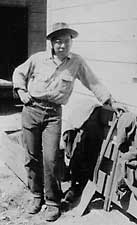
Sam Nakao, Delco, ID
Both the FBI and the Justice Department had determined before the war that only a very few Nikkei posed any threat to the U.S. As the "hysteria" that fueled the exclusion began to die down by the summer of 1942, official avenues of escape from the camps were sanctioned for the inmates. These reduced the expense of running the camps, allowed all citizens to participate in the war effort, and allowed students to continue their higher education.
Never allowed to return to their West Coast homes, citizens could leave the camps — with proper recommendations and sponsors — for short–term agricultural leaves to harvest essential crops, extended work release in another city, and the longer "indefinite leave" in another community. Kay and Sam Nakao, newly wed Islanders with infant son Bruce, began a lifelong friendship with Louis and Louise Dewey when Sam took a job on their Idaho farm. Many Islanders, like Paul Ohtaki, Tony Koura, and Sada Omoto, entered mid–West colleges to continue their formal education.
Oral History
Photo Information: Sam Nakao, Delco, ID — Worked on 3000 acre ranch during the war.
